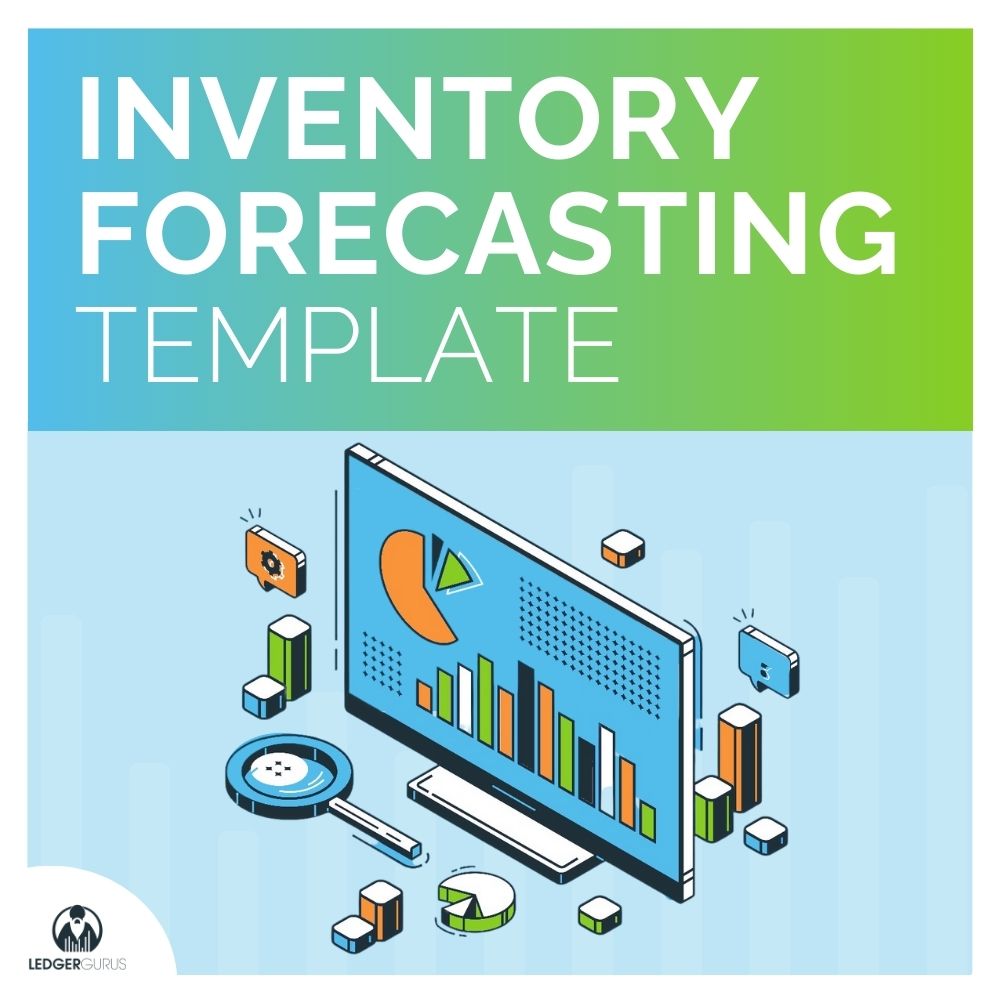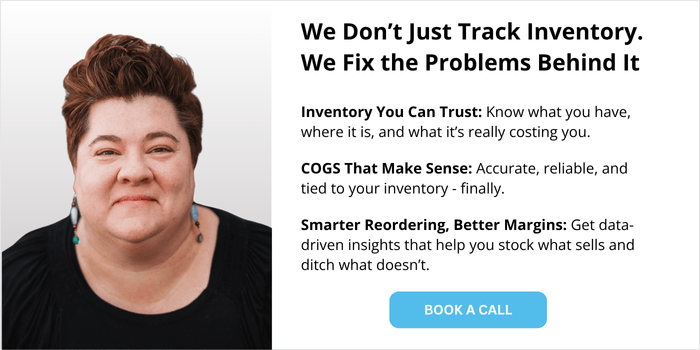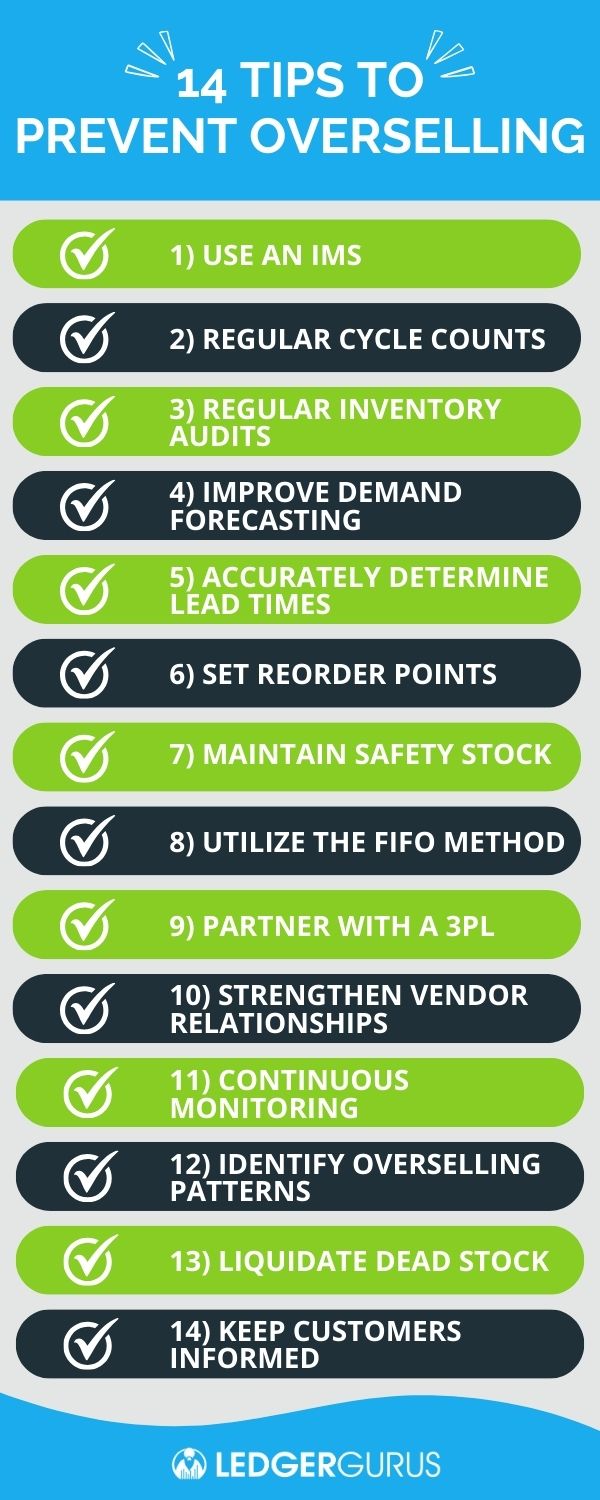Picture this: You’re an ecommerce seller managing your channel/s, juggling multiple products, and trying to keep up with the ever-fluctuating demands of your customers.
You’ve experienced the dreaded “overselling” scenario—running out of inventory for a popular product just when the orders are pouring in – and you are NOT impressed! Now you’re dealing with frustrated customers, lost sales, and a tarnished reputation, which are just a few of the headaches that come with stock outs.

If you’re nodding your head in agreement, you’re not alone. Many ecommerce businesses face this exact problem.
Our goal is to provide you with actionable tips and insights to help you keep your stock levels accurate and customers happy.
We’re going to share an invaluable tool to help you stay on top of your sales forecasting, so you don’t run out of product.
Plus, we’ll introduce you to the game-changing concept of an inventory management system (IMS) and how partnering with experts like LedgerGurus can make all the difference.
In this article, you’ll learn:
- What is Overselling?
- 7 Causes for Ecommerce overselling
- What is the cost of overselling your inventory?
- 14 Tips to prevent overselling
- Are you ready to get your overselling under control?
- FAQs
Let’s dive in!
Key Takeaways
- What is Overselling?
- Common Causes of Overselling
- The Cost of Overselling
- 14 Tips to Prevent Overselling
- Tools and Resources
What is Overselling?
Let’s start by defining the enemy: overselling, or stockouts.
This occurs simply when you have more orders for a product than you have inventory for that particular product. Unfortunately, this leaves your customers with empty shopping carts and a less-than-ideal shopping experience.
Keeping ecommerce inventory values accurate can be a constant struggle, and overselling can be pretty common, especially those who use Fulfilled by Merchant (FBM) with Amazon.
But why does overselling happen? Let’s explore some common culprits.
7 Causes for eCommerce Overselling
For whatever reason, your inventory numbers get off. Perhaps it’s because a customer comes into your brick and mortar retail store and buys something, but you forget to reflect that on your Amazon or Shopify store. That’s one less item available.
Or there are other reasons you may be experiencing this problem.
Inaccurate Demand Forecasting
Predicting customer demand is a bit like predicting the weather—sometimes it’s spot on, and other times, not so much.
Seasonal fluctuations can also make forecasting future demand challenging. Some products experience dramatic shifts in demand based on the season. Failing to adjust your inventory accordingly can lead to overselling during peak times.
Selling on multiple channels
If you sell on more than one channel and don’t have a consolidated source to track stock levels, overselling can be a recurring problem. Not only are you trying to manage inventory levels for your Amazon or Shopify store, but now you’re trying to do it across multiple sales channels.
Another issue of not having a good central system is that pending orders often don’t decrement inventory levels properly, leading to misleading numbers.
Supplier issues
Your suppliers play a vital role in your inventory management. Delays in production or shipping can throw a wrench in your inventory plans.
We’ve had experience with that recently with our own ecommerce store, Sole Toscana, and it has required some serious finagling to get our product in time so we don’t run out of stock before the new shipment comes in.
Poor inventory management
If your inventory is a chaotic mess, with no clear tracking system in place, stock outs become almost inevitable.
If you don’t have an accurate way of tracking inventory levels in your warehouse, you may find yourself guessing how much you have when you post your available stock to Amazon or your other channels. This can become a serious issue, especially when you get bumped to the Buy Box.
Overstocking other products
While your attention is often on running out of inventory for your main products, overstocking other products can indirectly contribute to the problem. It’s a delicate balance.
Unforeseen demand spikes
Sometimes, the unexpected happens—like a viral social media trend, a celebrity endorsement, or a global pandemic—that leads to a sudden surge in demand.
Are you prepared for such events?
Lack of safety stock
Safety stock acts as a buffer, a safety net for your inventory. Not having enough of it can leave you vulnerable to stock outs during unexpected situations.
What is the Cost of Overselling Your Inventory?
Overselling isn’t just a minor inconvenience; it can come with a hefty price tag.
Think about it: every time you run out of stock, you’re potentially losing money and sales, customer trust, and future business. The costs can add up quickly.
Also, when you make mistakes like this when you sell on Amazon, your Amazon seller rating can go down. You may find yourself with negative reviews, getting bumped from the Buy Box, leading to lost opportunities for sales, or even having your account suspended.
How Can You Avoid Overselling?
Now, let’s dive into the good stuff—how to prevent your online store from running out of stock and keep your ecommerce business thriving.
14 Tips to Prevent Overselling
Use an IMS
The very first tip for preventing overselling is to implement an Inventory Management Software (IMS).
This is like getting access to a GPS for your inventory. It helps you navigate your stock levels with precision and accuracy because everything is one place. All of your channels pull information from the same source that is updated in real-time.
For example, if you sell an item on Etsy, the IMS will automatically decrease what’s available on Amazon. It provides a single source of truth, which leads to increased clarity for operations, accounting, and purchasing.
This prevents overselling, which ultimately helps improve your customer’s experience.
Even if you only sell one channel, an IMS system will help tremendously because it gives you real-time updates of exactly what’s going on with your inventory at all times.
For more information, read The Top 10 Benefits of an Inventory Management Software.
Complete regular cycle counts
One of the most important things you can do is cycle counts, or stocktakes. This means to systematically count a subset of items on a rotating basis.
This is especially important with your most popular and high-value items, as well as any that have a history of accuracy issues.
Cycle counts are best if they are conducted frequently, often on a daily or weekly basis. The goal is to maintain ongoing inventory accuracy, catch errors, and prevent discrepancies from accumulating over time.
For more information inaccurate inventory counts, read Causes of Stock Discrepancies | Why Your Inventory Count is Off.
Carry out regular inventory audits
To maintain accurate inventory numbers, conduct full inventory audits annually or periodically.
This may sound the same as the cycle counts, but they’re not. An inventory audit is typically a comprehensive process that is more infrequent because it involves counting and reconciling all items in the inventory at the same time.
The main purpose is to provide a detailed and accurate snapshot of the entire inventory at a specific point in time (basically ensuring that your numbers for recorded and actual stock match), often for financial reporting or compliance purposes
This typically involves a larger team and more resources to count all the items in the inventory simultaneously, and the audit process may take longer to complete.
But it’s worth it to know exactly what you have on hand.
Improve demand forecasting
The next 3 tips work quite nicely together.
The first step is to analyze historical sales data, and market trends to make accurate predictions of how much you’re going to need and when.
For example, if you know you sold X amount of a certain product last year, and you know by what percentage you’ve grown so far this year, you can use that to get an idea of how much you’re going to need for the same time period this year and next. It isn’t an exact science, and no one has a crystal ball for this sort of thing, but it’s a whole lot better than making a shot in the dark.
If you are not on an IMS, we have a free Inventory Forecasting Template to help you with the process. We created this initially to use with our own ecommerce company, Sole Toscana, and found it to be helpful with our ecommerce accounting clients who haven’t gotten onto IMS tools yet, too.
Accurately determine lead times
The second step in this process is to work closely with suppliers to know how much lead time you can expect for product deliveries. You may also be able to work with them to reduce lead times.
Coming up with accurate lead times can be tricky because you have to factor in how long it takes to manufacture the product and get it to your warehouse.
Set reorder points
The last of this series of steps is to establish reorder points to automate the replenishment process when stock levels reach a certain threshold.
So, when your stock reaches whatever level you set, you know you’d better order more immediately to make sure you’ll have more before you run out.
Once again, you can do this without an IMS by using the Inventory Forecasting Template. It’s a seriously handy tool!
That said, an IMS will make this much easier.
Many other inventory management software tools have native reorder functions, and they will send you email or internal notifications when you’re reached your reorder point. From there, reorders can be automatically generated.
There are also purchasing and forecasting-specific software that connect to the IMS and have more analytical insights.
Maintain safety stock
Keep in mind that even if you’ve got the previous 3 steps dialed in, unexpected things can happen. The supply chain might be disrupted or you might suddenly have a unexpected spike in demand. This is awesome, but if you’re not prepared, it may be a real problem when it comes to fulfillment.
To combat this, it’s wise to keep a buffer of extra inventory, especially of your most popular products, to handle these demand spikes or supply disruptions.
Utilize the FIFO method
First-In, First-Out ensures that older stock is sold before newer stock, reducing the risk of obsolete or expired items. This is especially valuable for businesses dealing with products that have shelf lives, expiration dates, or varying product qualities.
Certain products, such as electronics or fashion items, may have variations or improvements over time. By selling the older stock first, you ensure that customers receive products with the latest features and enhancements.
This also simplifies inventory management. Implementing FIFO is straightforward and doesn’t require complex software or systems.
It also reduces holding costs and improves stock turnover.
Partner with a 3PL
Consider teaming up with a Third-Party Logistics (3PL) service provider to streamline your ecommerce operations.
3PLs offer warehousing solutions that provide additional storage space, efficient storage practices, and scalability to accommodate your business’s growth.
3PLs can help businesses maintain accurate stock levels and prevent overselling. Furthermore, they excel in order fulfillment, ensuring efficient order processing, faster shipping, and cost savings.
By outsourcing logistics to a 3PL, you can focus on core business activities, gain flexibility to adapt to demand fluctuations, and ultimately enhance your ecommerce success. It’s a strategic investment that empowers your business to thrive.
Strengthen vendor relationships
Building strong relationships with reliable suppliers plays a crucial role in preventing overselling.
Suppliers are more likely to prioritize businesses with whom they have strong relationships. This means that when you need to restock quickly due to unexpected demand, a supplier you’ve built a good relationship with is more likely to expedite your order and meet your urgent needs.
Suppliers who trust and value your business may offer more favorable terms and agreements. This could include flexible payment terms, volume discounts, or extended credit, which can free up capital for inventory investment and reduce financial constraints which can lead to stock outs.
Continuous monitoring
Stay vigilant by regularly tracking stock levels, customer feedback, and market changes. This will give you the ability to make timely and informed decisions to keep your inventory properly stocked.
Visibility into inventory levels and trends enables businesses to proactively respond to changes in demand. It also helps to identify slow-moving or obsolete inventory, allowing you to take action to clear or liquidate these items before they tie up valuable resources.
Continuous monitoring of your inventory also reduces the likelihood of inventory errors. When discrepancies are detected early, corrections can be made promptly, preventing overselling caused by inaccurate records.
Identify out of stock patterns
Analyze past stockouts to identify any recurring issues or trends. By analyzing historical inventory data, and recognizing recurring patterns, you can gain insights that will help you be more proactive and strategic with your inventory decisions.
You can anticipate and prepare for periods of heightened demand or supply chain disruptions. By understanding when and why stock outs tend to occur, you can refine your forecasts and safety stock calculations to be more precise.
For more information, read How to Calculate & Optimize Inventory Turnover for eCommerce Sellers.
Liquidate dead stock
Obsolete inventory ties up valuable storage space. Don’t let dead stock take up valuable space. Liquidate it to free up resources.
Keep customers informed
If you do oversell, communicate transparently with your customers about the situation. This builds trust by showing transparency and honesty, allowing customers to manage their expectations and make informed decisions. Businesses can offer alternatives or substitutions, potentially salvaging sales and encouraging customers to return when the item is back in stock. This can help mitigate the negative impact of running out of stock and is essential to maintain customer trust and loyalty.
Are You Ready to Get Your Overselling Under Control?
Learning how to avoid overselling is a critical challenge that every ecommerce seller must address to maintain customer satisfaction and business success.
We’ve covered a range of strategies to help you tackle this issue, from implementing an Inventory Management System (IMS) for precise inventory control to maintaining strong supplier relationships, continuously monitoring your stock, and more.
To take your stockout prevention efforts to the next level, we invite you to explore two valuable next steps:
Firstly, consider downloading our Inventory Forecasting Template, a powerful tool designed to assist you in accurately predicting demand and optimizing your inventory management, even if you haven’t yet adopted an IMS.
It will help you forecast the consumption of inventory through sales as closely as possible (remember, no crystal balls around here). It’ll also help you consider lead times so you know when you place the orders.
Secondly, if you’re ready to revolutionize your inventory management and take the guesswork out of stock control, consider partnering with LedgerGurus.
Our team of experts has 30+ years of experience implementing inventory management software, and can seamlessly implement an Inventory Management System tailored to your needs. This ensures accurate stock levels, efficient operations, and happier customers.
With the right tools and strategies, you can bid farewell to overselling and welcome a future of ecommerce success.
Reach out today so we can help you get all this under control.
 FAQs
FAQs
What to do if you do run out of stock?
Don’t panic. Communicate with customers, adjust your marketing strategies, and work diligently to restock as soon as possible.
How do you deal with stockouts?
Act swiftly by implementing the tips mentioned earlier, and use them as lessons to improve your inventory management.
What is the impact of stockouts on sales?
Stockouts can result in lost sales, dissatisfied customers, and long-term damage to your reputation.
How can businesses recover from a stockout situation?
Recover by expediting reordering, communicating with customers, and implementing better inventory management practices.






